49 found, showing page 3 of 4
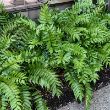
Height: 24 inches
Spread: 18 inches
Sunlight: partial shade, full shade
Hardiness Zone: 4b
Other Names: Hardy Holly Fern
Description:
The lovely, leathery, glossy fronds of this bold fern resemble those of a holly; keep moist but soil should be well-drained; cut back fronds as they get damaged; tolerates some sun; dies back to ground in colder climates
Ornamental Features:
Japanese Holly Fern is primarily valued in the garden for its cascading habit of growth. Its attractive glossy ferny leaves remain dark green in color throughout the year.
Landscape Attributes:
Japanese Holly Fern is an herbaceous evergreen fern with a shapely form and gracefully arching fronds. Its relatively fine texture sets it apart from other garden plants with less refined foliage.
This is a relatively low maintenance plant, and is best cleaned up in early spring before it resumes active growth for the season. It has no significant negative characteristics.
Japanese Holly Fern is recommended for the following landscape applications:
- Mass Planting
- Rock/Alpine Gardens
- Border Edging
- General Garden Use
- Naturalizing And Woodland Gardens
Planting & Growing:
Japanese Holly Fern will grow to be about 24 inches tall at maturity, with a spread of 18 inches. Its foliage tends to remain dense right to the ground, not requiring facer plants in front. It grows at a medium rate, and under ideal conditions can be expected to live for approximately 10 years. As an evegreen perennial, this plant will typically keep its form and foliage year-round.
This plant does best in partial shade to shade. It does best in average to evenly moist conditions, but will not tolerate standing water. It is particular about its soil conditions, with a strong preference for rich, acidic soils. It is somewhat tolerant of urban pollution. Consider applying a thick mulch around the root zone in both summer and winter to conserve soil moisture and protect it in exposed locations or colder microclimates. This species is not originally from North America. It can be propagated by division.
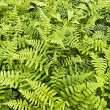
FERN 'GOLDEN SCALED MALED' 1QT
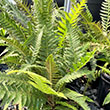
FERN 'JAPANESE BEECH' QT
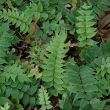
Height: 24 inches
Spread: 3 feet
Sunlight: partial shade, full shade
Hardiness Zone: 7b
Other Names: Polystichum falcatum, Japanese Netvein Holly Fern
Description:
The lovely, leathery, glossy fronds of this bold fern resemble those of a holly; keep moist but soil should be well-drained; cut back fronds as they get damaged; tolerates some sun
Ornamental Features:
Japanese Holly Fern is primarily valued in the garden for its cascading habit of growth. Its attractive glossy ferny leaves remain dark green in color throughout the year.
Landscape Attributes:
Japanese Holly Fern is an herbaceous evergreen fern with a shapely form and gracefully arching fronds. Its relatively fine texture sets it apart from other garden plants with less refined foliage.
This is a relatively low maintenance plant, and is best cleaned up in early spring before it resumes active growth for the season. It has no significant negative characteristics.
Japanese Holly Fern is recommended for the following landscape applications:
- Mass Planting
- Rock/Alpine Gardens
- Border Edging
- General Garden Use
- Naturalizing And Woodland Gardens
Planting & Growing:
Japanese Holly Fern will grow to be about 24 inches tall at maturity, with a spread of 3 feet. Its foliage tends to remain dense right to the ground, not requiring facer plants in front. It grows at a medium rate, and under ideal conditions can be expected to live for approximately 10 years. As an evegreen perennial, this plant will typically keep its form and foliage year-round.
This plant does best in partial shade to shade. It does best in average to evenly moist conditions, but will not tolerate standing water. It is particular about its soil conditions, with a strong preference for rich, acidic soils. It is somewhat tolerant of urban pollution. Consider applying a thick mulch around the root zone in both summer and winter to conserve soil moisture and protect it in exposed locations or colder microclimates. This species is not originally from North America. It can be propagated by division.
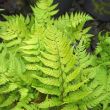
Height: 20 inches
Spacing: 14 inches
Sunlight: partial shade, full shade
Hardiness Zone: 5b
Other Names: Tsu-Sima Holly Fern
Description:
This easy to grow smaller size fern is great for any shaded area of the garden; also an excellent choice for container or indoor growing; dark stems contrast beautifully with the foliage adding tremendous interest; very resistant to pests and disease
Ornamental Features:
Korean Rock Fern is primarily valued in the garden for its cascading habit of growth. Its attractive ferny pinnately compound leaves remain forest green in color with distinctive black veins throughout the year.
Landscape Attributes:
Korean Rock Fern is an herbaceous evergreen fern with a shapely form and gracefully arching fronds. Its relatively fine texture sets it apart from other garden plants with less refined foliage.
This is a relatively low maintenance plant, and is best cleaned up in early spring before it resumes active growth for the season. Deer don't particularly care for this plant and will usually leave it alone in favor of tastier treats. It has no significant negative characteristics.
Korean Rock Fern is recommended for the following landscape applications:
- Mass Planting
- General Garden Use
- Groundcover
- Naturalizing And Woodland Gardens
Planting & Growing:
Korean Rock Fern will grow to be about 20 inches tall at maturity, with a spread of 16 inches. When grown in masses or used as a bedding plant, individual plants should be spaced approximately 14 inches apart. Its foliage tends to remain dense right to the ground, not requiring facer plants in front. It grows at a medium rate, and under ideal conditions can be expected to live for approximately 15 years. As an evegreen perennial, this plant will typically keep its form and foliage year-round.
This plant does best in partial shade to shade. It requires an evenly moist well-drained soil for optimal growth, but will die in standing water. It is not particular as to soil pH, but grows best in rich soils. It is somewhat tolerant of urban pollution, and will benefit from being planted in a relatively sheltered location. Consider applying a thick mulch around the root zone over the growing season to conserve soil moisture. This species is not originally from North America, and parts of it are known to be toxic to humans and animals, so care should be exercised in planting it around children and pets. It can be propagated by division.
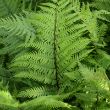
Height: 3 feet
Spread: 24 inches
Sunlight: partial shade, full shade
Hardiness Zone: 3a
Other Names: Athyrium angustum f. rubellum
Description:
Attractive dark green fronds with deep maroon-red central stems; clump-forming and dense, perfect for shady spots; beautiful in masses on the edges of ponds or streams
Ornamental Features:
Lady in Red Fern is primarily valued in the garden for its cascading habit of growth. Its attractive ferny bipinnately compound leaves emerge antique red in spring, turning dark green in color throughout the season. The red stems are very colorful and add to the overall interest of the plant.
Landscape Attributes:
Lady in Red Fern is a dense herbaceous fern with a shapely form and gracefully arching fronds. It brings an extremely fine and delicate texture to the garden composition and should be used to full effect.
This is a relatively low maintenance plant, and usually looks its best without pruning, although it will tolerate pruning. Deer don't particularly care for this plant and will usually leave it alone in favor of tastier treats. It has no significant negative characteristics.
Lady in Red Fern is recommended for the following landscape applications:
- Mass Planting
- Border Edging
- General Garden Use
- Groundcover
- Naturalizing And Woodland Gardens
Planting & Growing:
Lady in Red Fern will grow to be about 3 feet tall at maturity, with a spread of 24 inches. Its foliage tends to remain dense right to the ground, not requiring facer plants in front. It grows at a slow rate, and under ideal conditions can be expected to live for approximately 15 years. As an herbaceous perennial, this plant will usually die back to the crown each winter, and will regrow from the base each spring. Be careful not to disturb the crown in late winter when it may not be readily seen!
This plant does best in partial shade to shade. It prefers to grow in moist to wet soil, and will even tolerate some standing water. It is particular about its soil conditions, with a strong preference for rich, acidic soils. It is somewhat tolerant of urban pollution, and will benefit from being planted in a relatively sheltered location. Consider applying a thick mulch around the root zone over the growing season to conserve soil moisture. This is a selected variety of a species not originally from North America, and parts of it are known to be toxic to humans and animals, so care should be exercised in planting it around children and pets. It can be propagated by division; however, as a cultivated variety, be aware that it may be subject to certain restrictions or prohibitions on propagation.
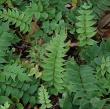
Arching, glossy, dark green fronds. Naturalizing. Evergreen. USDA 6-10
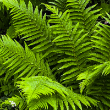
Height: 4 feet
Spread: 4 feet
Sunlight: partial shade, full shade
Hardiness Zone: 4a
Other Names: Common Male Fern
Description:
Graceful, arching fronds of forest green foliage, a vigorous grower; attractive fiddleheads unfurl in spring; keep evenly moist, provides habitat and shelter for birds and bees
Ornamental Features:
Male Fern is primarily valued in the landscape or garden for its cascading habit of growth. Its tiny ferny compound leaves remain green in color throughout the year.
Landscape Attributes:
Male Fern is an herbaceous evergreen fern with a shapely form and gracefully arching fronds. It brings an extremely fine and delicate texture to the garden composition and should be used to full effect.
This is a relatively low maintenance plant, and should be cut back in late fall in preparation for winter. Deer don't particularly care for this plant and will usually leave it alone in favor of tastier treats. It has no significant negative characteristics.
Male Fern is recommended for the following landscape applications:
- Mass Planting
- General Garden Use
- Naturalizing And Woodland Gardens
Planting & Growing:
Male Fern will grow to be about 4 feet tall at maturity, with a spread of 4 feet. Its foliage tends to remain dense right to the ground, not requiring facer plants in front. It grows at a medium rate, and under ideal conditions can be expected to live for approximately 15 years. As an evegreen perennial, this plant will typically keep its form and foliage year-round. As this plant tends to go dormant in summer, it is best interplanted with late-season bloomers to hide the dying foliage.
This plant does best in partial shade to shade. It prefers to grow in average to moist conditions, and shouldn't be allowed to dry out. It is particular about its soil conditions, with a strong preference for rich, acidic soils. It is somewhat tolerant of urban pollution. Consider applying a thick mulch around the root zone over the growing season to conserve soil moisture. This species is native to parts of North America, and parts of it are known to be toxic to humans and animals, so care should be exercised in planting it around children and pets. It can be propagated by division.
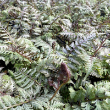
Height: 18 inches
Spread: 24 inches
Sunlight: partial shade, full shade
Hardiness Zone: 3b
Other Names: Crested Japanese Painted Fern
Description:
An excellent choice for adding fine textures to garden beds and borders; features a low growing habit with arching gray-green fronds with silver variegations; easy to grow, requiring little to no maintenance; shade loving variety
Ornamental Features:
Pewter Lace Painted Fern is primarily valued in the garden for its cascading habit of growth. Its attractive ferny bipinnately compound leaves emerge burgundy in spring, turning grayish green in color with showy silver variegation throughout the season. The burgundy stems are very colorful and add to the overall interest of the plant.
Landscape Attributes:
Pewter Lace Painted Fern is a dense herbaceous fern with a shapely form and gracefully arching fronds. It brings an extremely fine and delicate texture to the garden composition and should be used to full effect.
This is a relatively low maintenance plant, and usually looks its best without pruning, although it will tolerate pruning. Deer don't particularly care for this plant and will usually leave it alone in favor of tastier treats. It has no significant negative characteristics.
Pewter Lace Painted Fern is recommended for the following landscape applications:
- Mass Planting
- Border Edging
- General Garden Use
- Groundcover
- Naturalizing And Woodland Gardens
Planting & Growing:
Pewter Lace Painted Fern will grow to be about 18 inches tall at maturity, with a spread of 24 inches. Its foliage tends to remain dense right to the ground, not requiring facer plants in front. It grows at a slow rate, and under ideal conditions can be expected to live for approximately 15 years. As an herbaceous perennial, this plant will usually die back to the crown each winter, and will regrow from the base each spring. Be careful not to disturb the crown in late winter when it may not be readily seen!
This plant does best in partial shade to shade. It prefers to grow in moist to wet soil, and will even tolerate some standing water. It is particular about its soil conditions, with a strong preference for rich, acidic soils. It is somewhat tolerant of urban pollution, and will benefit from being planted in a relatively sheltered location. Consider applying a thick mulch around the root zone over the growing season to conserve soil moisture. This is a selected variety of a species not originally from North America, and parts of it are known to be toxic to humans and animals, so care should be exercised in planting it around children and pets. It can be propagated by division; however, as a cultivated variety, be aware that it may be subject to certain restrictions or prohibitions on propagation.
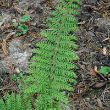
Height: 30 inches
Spacing: 26 inches
Sunlight: partial shade, full shade
Hardiness Zone: 5b
Description:
A very soft textured fern variety; excellent massed or as groundcover in shaded woodland borders or featured in shady areas of rock gardens; evergreen in mild winter areas
Ornamental Features:
Shield Fern is primarily valued in the garden for its cascading habit of growth. Its attractive ferny pinnately compound leaves remain forest green in color throughout the year.
Landscape Attributes:
Shield Fern is an herbaceous evergreen fern with a shapely form and gracefully arching fronds. Its relatively fine texture sets it apart from other garden plants with less refined foliage.
This is a relatively low maintenance plant, and is best cleaned up in early spring before it resumes active growth for the season. Deer don't particularly care for this plant and will usually leave it alone in favor of tastier treats. It has no significant negative characteristics.
Shield Fern is recommended for the following landscape applications:
- Mass Planting
- General Garden Use
- Groundcover
- Naturalizing And Woodland Gardens
Planting & Growing:
Shield Fern will grow to be about 30 inches tall at maturity, with a spread of 30 inches. When grown in masses or used as a bedding plant, individual plants should be spaced approximately 26 inches apart. Its foliage tends to remain dense right to the ground, not requiring facer plants in front. It grows at a medium rate, and under ideal conditions can be expected to live for approximately 15 years. As an evegreen perennial, this plant will typically keep its form and foliage year-round.
This plant does best in partial shade to shade. It requires an evenly moist well-drained soil for optimal growth, but will die in standing water. It is not particular as to soil pH, but grows best in rich soils. It is somewhat tolerant of urban pollution, and will benefit from being planted in a relatively sheltered location. Consider applying a thick mulch around the root zone over the growing season to conserve soil moisture. This is a selected variety of a species not originally from North America, and parts of it are known to be toxic to humans and animals, so care should be exercised in planting it around children and pets. It can be propagated by division; however, as a cultivated variety, be aware that it may be subject to certain restrictions or prohibitions on propagation.
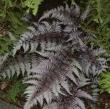
Height: 18 inches
Spread: 24 inches
Sunlight: partial shade, full shade
Hardiness Zone: 4a
Other Names: Crested Japanese Painted Fern
Description:
Attractive tri-color fronds of silver, red and pale green; colorful maroon-red central stems and veins; compact and dense, perfect for shady spots; beautiful in masses on the edges of ponds or streams
Ornamental Features:
Regal Red Painted Fern is primarily valued in the garden for its cascading habit of growth. Its attractive twisted ferny bipinnately compound leaves emerge dark red in spring, turning silver in color with pointy dark red spines throughout the season. The red stems are very colorful and add to the overall interest of the plant.
Landscape Attributes:
Regal Red Painted Fern is a dense herbaceous fern with a shapely form and gracefully arching fronds. It brings an extremely fine and delicate texture to the garden composition and should be used to full effect.
This is a relatively low maintenance plant, and usually looks its best without pruning, although it will tolerate pruning. Deer don't particularly care for this plant and will usually leave it alone in favor of tastier treats. It has no significant negative characteristics.
Regal Red Painted Fern is recommended for the following landscape applications:
- Mass Planting
- Border Edging
- General Garden Use
- Groundcover
- Naturalizing And Woodland Gardens
Planting & Growing:
Regal Red Painted Fern will grow to be about 18 inches tall at maturity, with a spread of 24 inches. Its foliage tends to remain dense right to the ground, not requiring facer plants in front. It grows at a slow rate, and under ideal conditions can be expected to live for approximately 15 years. As an herbaceous perennial, this plant will usually die back to the crown each winter, and will regrow from the base each spring. Be careful not to disturb the crown in late winter when it may not be readily seen!
This plant does best in partial shade to shade. It prefers to grow in moist to wet soil, and will even tolerate some standing water. It is particular about its soil conditions, with a strong preference for rich, acidic soils. It is somewhat tolerant of urban pollution, and will benefit from being planted in a relatively sheltered location. Consider applying a thick mulch around the root zone over the growing season to conserve soil moisture. This is a selected variety of a species not originally from North America, and parts of it are known to be toxic to humans and animals, so care should be exercised in planting it around children and pets. It can be propagated by division; however, as a cultivated variety, be aware that it may be subject to certain restrictions or prohibitions on propagation.
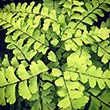
Finely textured frilly fronds. Wiry stems. Native. Clumping. USDA 3-8
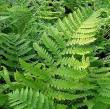
FERN 'WESTERN SWORD' 1G
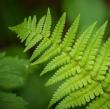
FERN 'BEAUTIFUL WOOD' 1G
49 found, showing page 3 of 4